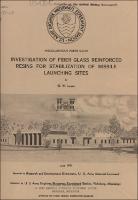Please use this identifier to cite or link to this item:
https://hdl.handle.net/11681/20685Full metadata record
| DC Field | Value | Language |
|---|---|---|
| dc.contributor | United States. Army Materiel Command | - |
| dc.contributor.author | Leese, G. W. (Grady W.) | - |
| dc.date.accessioned | 2017-01-17T21:33:46Z | - |
| dc.date.available | 2017-01-17T21:33:46Z | - |
| dc.date.issued | 1971-06 | - |
| dc.identifier.uri | http://hdl.handle.net/11681/20685 | - |
| dc.description | Miscellaneous Paper | - |
| dc.description | Abstract: Experience with Army tactical rockets and missiles has shown that during launchings over unprotected soil surfaces, the motor blast produces dust clouds that could reveal the firing location to the enemy and causes soil erosion in the launch area detrimental to reloading and operating conditions. As the tactical missiles and rockets are used as artillery and antiaircraft weapons in close support of forward-area ground operations, attenuation of dust clouds and control of ground erosion are considered essential for personnel and equipment protection and for camouflage and concealment. Tests using small rocket motors were made at the U. S. Army Engineer Waterways Experiment Station on blast-resistant materials and combinations of materials at exposure temperatures up to 3800 °F to select the most favorable combination of materials for field testing. Field tests of materials were conducted with the Honest John and Little John rockets, both operational weapons, at the White Sands Missile Range, N. Mex. Based on results obtained in this investigation, the following conclusions are believed warranted: (A.) .A ground cover constructed of high-heat-resistant polyester resin reinforced with glass will withstand the direct blast from the motor of the Little John rocket, and (B.) The use of a fence around two sides and along the rear edge of the firing pad will substantially reduce the areal extent of ground protection required for alleviating dust cloud formation during launch. NOTE: This file is very large. Allow your browser several minutes to download the file. | - |
| dc.publisher | U.S. Army Engineer Waterways Experiment Station. | - |
| dc.publisher | Engineer Research and Development Center (U.S.) | - |
| dc.relation | http://acwc.sdp.sirsi.net/client/en_US/search/asset/1048266 | - |
| dc.rights | Approved for public release; distribution is unlimited. | - |
| dc.source | This Digital Resource was created from scans of the Print Resource | - |
| dc.subject | Blast-resistant materials | - |
| dc.subject | Dust control | - |
| dc.subject | Erosion control | - |
| dc.subject | Fiber glass reinforced plastics | - |
| dc.subject | Launching sites | - |
| dc.subject | Missile launching sites | - |
| dc.subject | Soil stabilization | - |
| dc.subject | Synthetic resins | - |
| dc.subject | Soil stabilization | - |
| dc.title | Investigation of fiber glass reinforced resins for stabilization of missile launching sites | - |
| dc.type | Report | en_US |
| Appears in Collections: | Miscellaneous Paper | |
Files in This Item:
| File | Description | Size | Format | |
|---|---|---|---|---|
| MP-S-71-19.pdf | 77.65 MB | Adobe PDF |  View/Open |